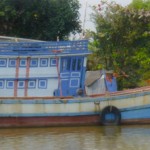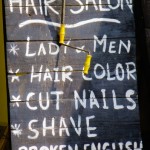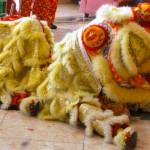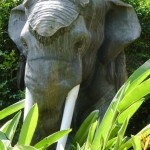Waking up in Battambang this was so different from being in Siem Riep, no tuk tuks rushing past….little did we know our day would see us climbing a million stairs and racing through the countryside on a Norry.
We started the day with breakfast at the Cold Night restaurant which is two doors down from our guesthouse. It’s Chinese New Year and it seemed every Chinese in Battambang were there having breakfast. When we arrived all the heads in he place swivelled around and looked at us as if to say “quick hide the silverware and anything stealable Australians have just walked in”.
The Cold Night is a pretty fancy restaurant with a large under roof alfresco area, 6 huts on either side of the alfresco area which seat about ten, and other air conditioned dining areas. The wait staff were busy when we arrived as car after car arrived to drop off guests but we found a table and ordered coffee, poached eggs, toast and an omelette. The meals were pretty low grade and the coffee could’ve filled one of the many potholes that pockmark the roads. We should have selected a local meal.
Our Tour guide Chantha arrived in his Tuk Tuk just before 9 and we headed to the Ta Dambong Kro Nhung Statue. Legend has it that about 2,000 years ago a local cow herder found a magical staff and used it to depose the King, and name himself King Dambung(King stick). He later had a vision that within 7 years, 7 months and 7 days a monk on a white horse would depose him so logically killed off all the holy men. As predicted a man (actually the deposed kings son) arrived on a horse dressed in robes(he’d borrowed) King Dambong threw his magical staff which by this stage had lost its magical power and King Dambung fled. The staff landed on the banks of the river at what is now known as Battambang (loss of staff). The huge statue is on a roundabout and people pray and give offerings for good luck, beneath it. They just park their cars on the exit of the roundabout and make their offerings. Today we saw locals, loading a full roast suckling pig, fruit and even a case of bottled water back into the car after they made it as an offering. We were told the offering only has to be there until the incense burns down and then it can be taken away. Waste not, want not….especially in a poor country.
We took a detour through some of Battambang’s back streets, through a Chinese cemetery, and soon arrived at O’Dambong the home of the famous Bamboo train or Norry as it’s called locally after the French word for Lorry. There’s an old abandoned railway track the locals have been using to transport rice,animals,all sorts of goods and passengers. It only costs USD $5 each for a 12 km ride to O’Sralau village and back, so quite cheap. All a Norry consists of is, a wooden and bamboo tray, two sets of wheeled axle (one with A Slow Boat To Battambang a pulley) and a 3.5 hp motor pull start with a pulley on the side. To make it go the driver pulls back on a stick which pulls the motor (which is on a slide) back creating tension on the drive belt. (Bloody ingenious)
Very soon we were hurtling along the rickety old tracks at about 30mph with Michele holding onto my leg for dear life, until we met another Norry coming the opposite direction. The rule is that the heaviest load or the train with the least passengers stops and dismantles their train.Coming towards us was a busload of people in a convoy so we had to get off the line.
No problems. Our driver, the only female on the track, just slackened and removed the drive belt(by pushing forward on the stick). Then two people lifted the bamboo tray off and the two axles and the track was clear. Yes really that simple. Getting going again was just the opposite. Putting the two axles on the track, then the tray, pulled the belt over the pulley on the motor, started the motor, pulled back on the stick and putt putt putt putt clack clack clack clack we were off again. We did this a few times before reaching the end of the line where there was a refreshment area and souvenirs for sale.
We wondered around looking at the stalls while an older Mum and her 20 year old daughter playfully begged us to buy drinks, TShirts and of course elephant pants. There were some young kids weaving grasshoppers and stars out of palm leaves and they gave Michele one of each “free” before asking for money for cotton bracelets. We sat at one of the stalls and bought a few cokes and stated talking to an English guy who was drinking a local Khmer coffee so I ordered one as well which was just like Vietnamese coffee so really nice. He talked for a while about teaching in Vietnam which he’d been doing for a ten years and it was great to get some tips which may come in handy later.
The coffee hit the spot and also got things moving so I asked to use the facilities. The mum lead me to a little lean, past water busily boiling on a fire, to a little door which opened to an open air squat roughly fenced with corrugated iron, there was a large pot of water and a bowl for washing yourself. I must admit it was pretty rustic with holes between the sheets so I could see outside, but it was clean, quite usable and overall quite a nice experience.
The ride back was much the same with having to stop and dismantle the Norry whenever we met another one. At one stop our Norry wouldn’t restart and no matter what our driver did she couldn’t pull start it. We had help form the next Norry who gave us a push and as we picked up speed our driver leaned back on the stick to create tension on the drive belt turning the pulley on the motor and after a while the motor begrudgingly started and we were hustling along the tracks back to the start. We tipped the driver $2 as we were told they live off tips and boarded our Tuk Tuk and headed off.
Chantha took us to a small local Rice mill, not much larger than our hotel room, where locals bring their rice to be milled into white rice. From the original rice 70 percent is converted into white rice and returned to the farmer (for free), while the rest of the byproducts of husk, cracked rice, rice powder which are retained by the mill as a fee. Of the remaining 30 percent, the husks are burnt in cooking fires and the charcoal from this spread on the rice fields as fertiliser, the rice powder is used for making rice paper and the cracked rice is used for animal feed, so nothing is wasted.
Our next stop was a suspension bridge over the Sung Sangkaé where we took photos of farmers growing crops of corn and vegetables on the riverbanks. During the wet season the river floods and covers the riverbanks with silt providing natural fertiliser for the dry season. There were also fishermen who had staked tree branches in the river providing a spot for fish to spawn. In this part of the river during this time of year fishermen are not allowed to net fish as it’s breeding season. So they provide hatcheries and later will surround their staked areas with nets and remove the branches and will have a small fish farm. Next thing we knew it was rush hour on the bridge with scores of motorbikes loaded up with two or more people trying to cross we hugged the side of the bridge as it dipped at an angle as the motorbikes passed.
We continued our journey through a Cham viilage. The local Chams are Muslims who originally came from Vietnam around Saigon but during the war were forced to flee to neighbouring countries. The little village supports itself by fishing and a little farming.
We bumped our way through the little villages through the farming areas, stopping briefly to check out a few market gardens and back onto an unsealed road which was under construction, so the ride was horrendous but fun. We even walked through some area of road which were too rough as Chanytha slowly drove the tuk tuk through.
It was a nice scenic ride however with views of rice fields, farms and houses with the underneath jam packed with bags of rice. The houses were of all built of different materials with big concrete houses, smaller wooden houses on stilts and Atap houses. We passed farmers with tractors piled high, motorbikes dragging trailers and utes filled with about twenty people.
We had a brief stop on the side of the road because the road was so bumpy and we spotted some kids fishing in a mud puddle with their hands and feet. While we were there one kid caught a snakehead fish about 5 inches long which went into the catch bottle.
Temple Banan was our next stop, a temple older than those at Angkor Wat but not as crowded. The temple is at the top of a steep hill with over three hundred steps leading to it. We decided to have lunch first and Chantha showed us the cheapest and best little restaurant which was a tarp stretched between a few trees with ladies cooking over a wood fire. I ordered Beef in Ginger and rice, Michele Stir Fried Pork and Chantha Fried rice with egg. Chantha showed us some boiled duck eggs including one with the embryo in which I politely declined (I still remember, not so fondly the one I ate in Vietnam urgh)
Meanwhile, Michele had found a friend in an old lady who had spotted that Michele was hot so was busily fanning her. She happily continued whilst Michele was eating and once she considered Michele was cool enough started massaging her back, shoulders and arms. We gave her a small token of our appreciation.
After lunch we slowly climbed the stairs passing beggars all the way to the top briefly stopping at various levels to catch our breath. Michele was escorted the whole way by a small girl who fanned her but at times I wasn’t too sure whether she was fanning or trying to whip Michele’s butt to keep her going.lol
When we reached the top we discovered five ramshackle old temple buildings in various stages of disrepair with danger signs around the outside, which date back to 1050 and were originally Hindu. The first on on the crest of the hill had a Buddha and people stopped to pray before proceeding on to the central temple where the larger Buddha sat. It was obvious that this temple was very much in use by locals with so many praying. We took a break and a small girl about three approached asking for “money for school” repeating it in learnt fashion which was quite puzzling, as education is free. There was a small god house at the rear of the complex which seemed quite popular for prayer.
We took a few photos and made our way to the bottom stopping at a rest stop where we met Peter and Lily from Den Hague in Holland. They were a really nice couple and we spent a while chatting about travelling. We told them of our plan to travel overland to Europe and they told us we must visit when we are in Holland. Just another example of the nice people you meet travelling. We said our goodbyes and safe travels, they headed up and we headed down. We passed some monks who had just made it to the rest stop and were standing around hands on hips, out of breath, puffing hard even updating their facebook statuses. For some reason this was quite reassuring.
Chantha was waiting for us and we headed for our next destination over bumpy dirt roads through fields passing waving kids and smiling locals.
Our next stop was Phnom Sampeau (Shiplike Mountain) where we visited the Buddhist temple. To get to the top we had a choice of walking up the stairs, (which was not an option after the previous one), up the winding path (about an hour so not an option) or on the back of a motorbike taxi for $3 each up and back (great option). Phnom Sampeau wasn’t a place you’d visit for fun however the visit must be made so that those who lost their lives story is told.
The Buddhist temple was occupied by the Khmer Rouge and converted into a prison and victims of the Khmer Rouge were sent here to be raped, tortured, terrorised and bludgeoned to death before their bodies were thrown into the caves. Some also were still alive as they were tossed 30 metres down into the darkened caves. Around the area about 14,000 people were murdered and at Wat Someong Knong cannibalism was introduced. When the Khmer Rouge were overthrown the caves were opened up and today there is memorial to those who lost their lives including skulls of adults and children. It’s also a place of quiet reflection and contemplation where given an opportunity of how brutal humans can be. We were guided by a young man (who was also Michele’s motorcycle driver) working to put himself through university who told us of the horrors, his parents were only young children but remember working like slaves on the Khmer Rouge camps.
We had a look at the other pagoda and dodged the monkeys on the lookout for water bottles and loose items to steal, before returning to the bottom of the hill for some refreshments and a toilet stop. We made our way to a wall with tourists and locals, not far from the shops. It was here we overheard an english woman asking her guide “are the US dollars they use here are the same ones they use in the US”…..what the??
Just on 5.30 the hill came alive as millions and millions of tiny bats flew from the hill like a scene from a horror movie. Unfortunately the bats weren’t vampire bats but insect eating bats and they had a big task ahead of them eating all the mosquitoes around Battambang so were hurrying to get on with it. It was quite surprising how many came out in a steady procession an when they came out they were like waves.
As the sun dipped over the horizon we made our way back to the hotel, said our thanks and goodbyes to Chantha and made our way to the Bamboo Train Cafe and Bar for tea. I had a delicious Red Curry Chicken washed down with a Mango Lassi and Michele ginger Chicken with Mushroom and a Lime Juice. The meals and the service was excellent . The cafe is a bit off the beaten track so was pretty quiet as its coming into low season. The owner also gave us some of her jackfruit she’d picked. We bid our goodbyes walked the short distance and after doing the communal duties of washing clothes and showering it was time for bed to prepare ourselves for another day of taking in the sights of Battambang.


























I really enjoyed Battambang, and specifically its cafe culture. I only spent two days there, but on my next visit I’ll definitely be there for longer.
Yes we wish we had spent longer too 🙂